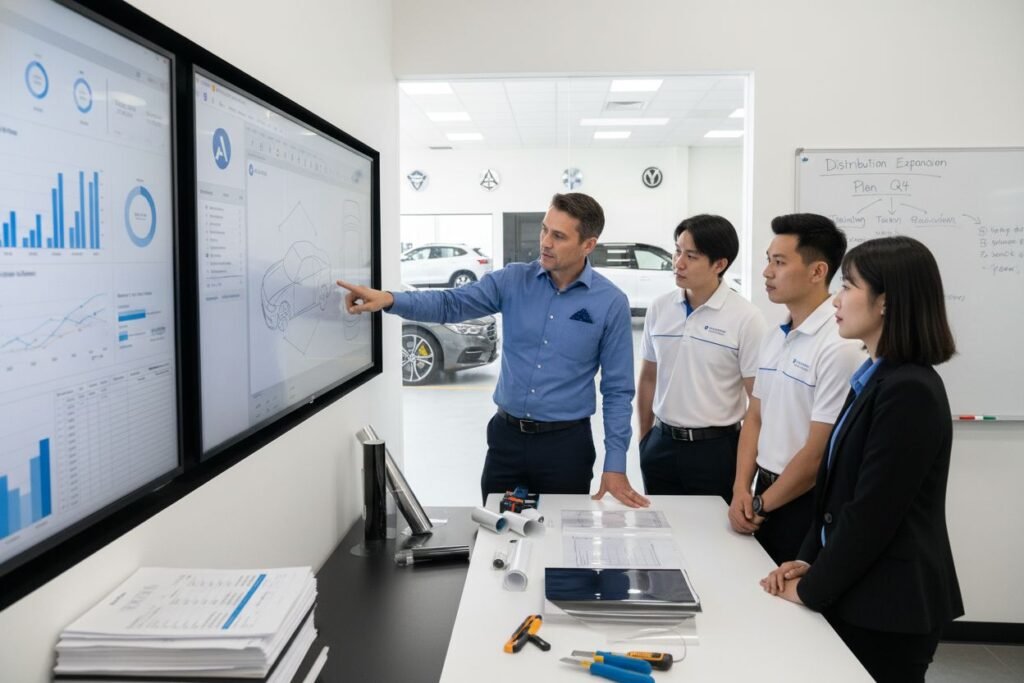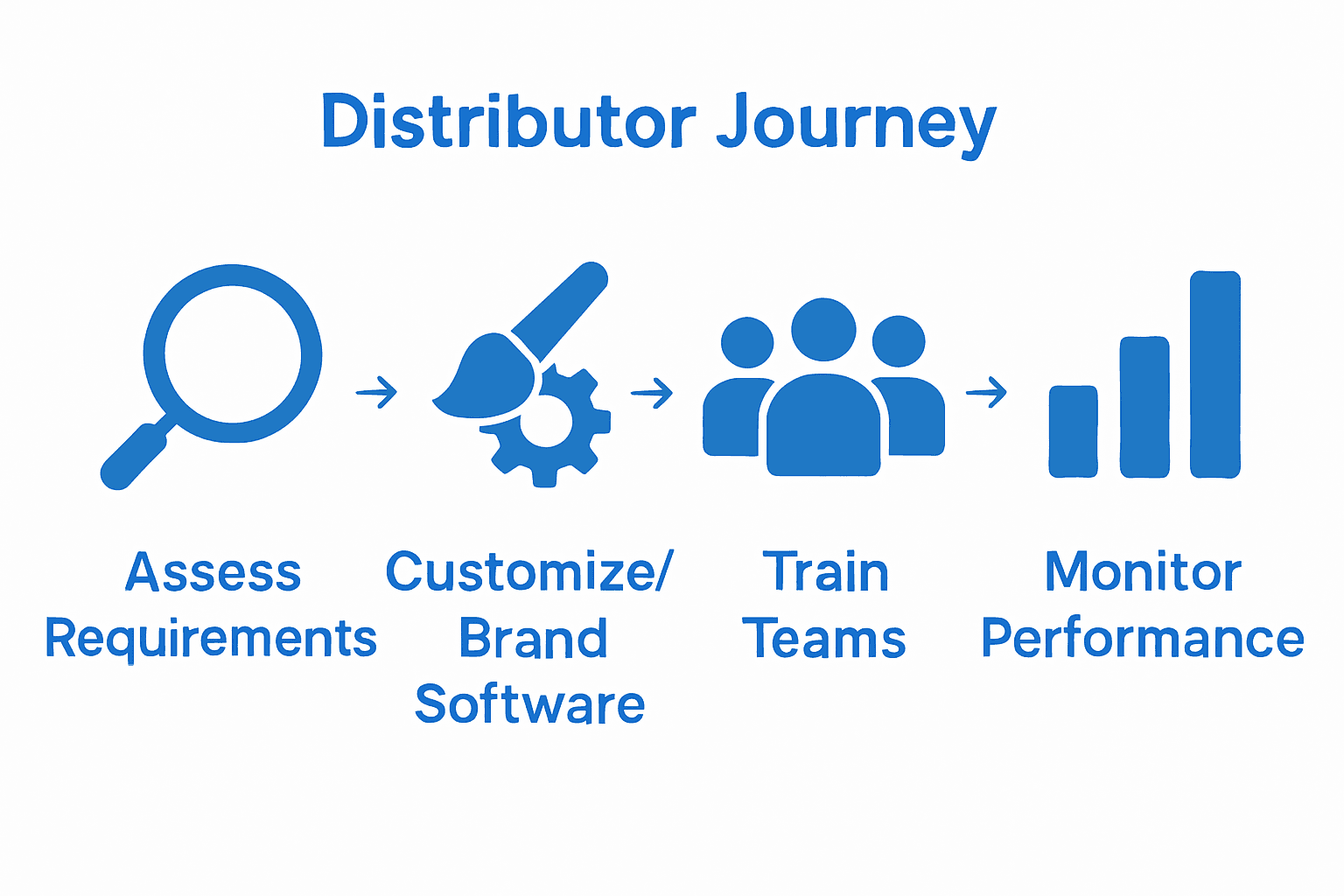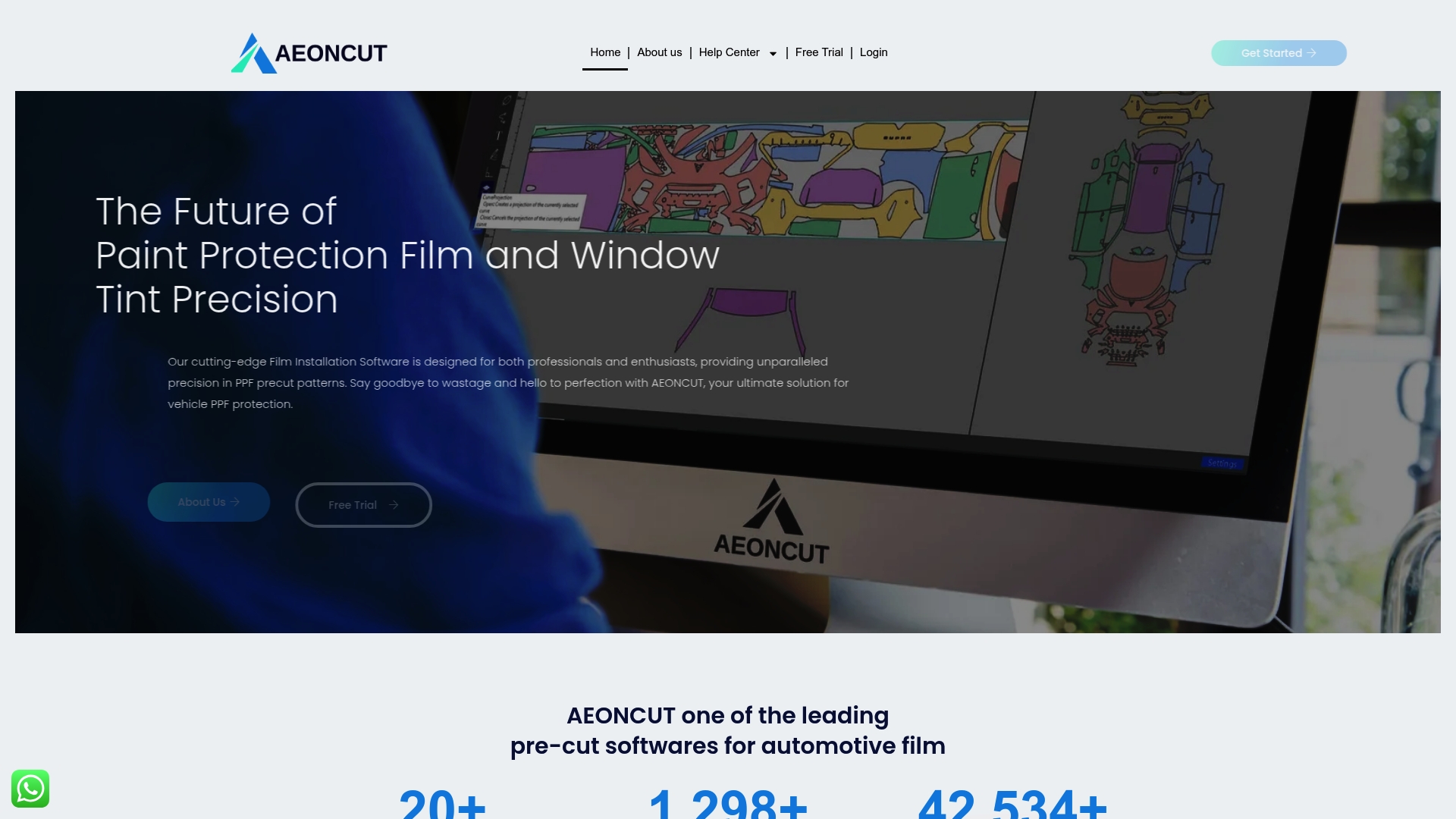
Nearly 90 percent of new automotive software distributors struggle with unmet market expectations in their first year. The path to becoming a trusted provider of paint protection film (PPF) software demands more than industry enthusiasm. Knowing how to assess your resources, industry connections, and regional needs sets you apart. This guide breaks down the crucial first steps, helping you uncover what distributors need and how to match those demands for meaningful entry into the automotive customisation market.
Quick Summary
| Key Point | Explanation |
|---|---|
| 1. Assess Your Distribution Requirements | Understand industry experience, market connections, and operational capabilities necessary for success. |
| 2. Choose Customizable PPF Software | Select software with extensive vehicle coverage and user-friendly features for your distribution strategy. |
| 3. Integrate Your Unique Branding | Implement a cohesive brand identity throughout the white label software for a professional presence. |
| 4. Deliver Comprehensive Team Training | Ensure your team is well-trained in software usage and installation techniques for effective launch. |
| 5. Monitor and Optimize Software Performance | Regularly track key metrics to identify improvement areas and enhance overall distributor efficiency. |
Table of Contents
- Step 1: Identify Distributor Requirements And Market Needs
- Step 2: Select And Customize White Label PPF Software Features
- Step 3: Integrate Branding And Establish Distributor Accounts
- Step 4: Train Teams And Launch The White Label Offering
- Step 5: Monitor Performance And Optimize Software Usage
Step 1: Identify Distributor Requirements and Market Needs
In this step, you will learn how to systematically evaluate and understand the critical requirements for becoming a successful PPF software distributor. Identifying market needs and distributor criteria helps you build a strategic roadmap for entering this competitive automotive customisation sector.
Successful distribution begins with a thorough assessment of your current capabilities and market potential. According to Apeax’s distributor guidelines, key eligibility factors include demonstrating prior automotive industry experience, having a clear market expansion strategy, and possessing appropriate infrastructure for warehousing and training.
Start by conducting a comprehensive self evaluation. What existing automotive connections do you have? Do you currently serve car care professionals or window tinting businesses? Your network and industry relationships will be crucial initial assets. Review your current facility resources carefully consider whether you can meet operational prerequisites such as storage space, training capabilities, and technical support infrastructure.
Here is a summary of critical distributor requirements and market needs to assess before entry:
| Requirement Area | Key Questions | Why It Matters |
|---|---|---|
| Industry Experience | Any relevant automotive background? | Demonstrates credibility and readiness |
| Market Connections | Existing network in car care or tinting? | Facilitates early sales and partnerships |
| Facility & Resources | Adequate storage, training, support? | Supports efficient operations and growth |
| Regional Market Trends | Which PPF solutions are in demand locally? | Informs product focus and marketing |
| Strategic Planning | Clear roadmap for expansion? | Shows long-term commitment and vision |
Your market research should focus on understanding regional automotive customisation trends. What types of vehicle protection solutions are most in demand? Are luxury car owners seeking premium PPF options? Are fleet management companies looking for cost effective protection solutions? Each regional market will have unique characteristics that influence software and film distribution potential.
Pro Tip: Document your market analysis meticulously. A well structured research report will significantly strengthen your distributor application and demonstrate professional preparedness.
The next critical step involves preparing a detailed business plan that outlines your strategy for introducing PPF cutting software to your target market. This plan should articulate your sales targets, marketing approach, and projected growth trajectory.
Moving forward, you will need to compile your research findings into a compelling distributor application package that showcases your readiness and strategic vision for bringing innovative PPF solutions to automotive professionals.
Step 2: Select and Customize White Label PPF Software Features
This step walks you through the critical process of selecting and tailoring white label PPF software features that align perfectly with your distribution strategy and market needs. Understanding how to customize software capabilities will determine your competitive edge in the automotive protection market.
According to research from Yink Global, successful distributors focus on software solutions with expansive pattern databases and real time update capabilities. Start by evaluating software platforms that offer comprehensive vehicle model coverage across different regions. Look for solutions with over 350,000 vehicle patterns that can serve diverse automotive markets.
Key customization considerations include machine compatibility machine interface design and pattern accessibility. According to SlaByte’s Autocut PPF Software insights, an intuitive interface allows easier adoption for your installer network. Prioritize software platforms that offer seamless integration with multiple cutting machine brands and provide user friendly customization options.
Your selection process should include thoroughly testing remote control features automated nesting capabilities and update mechanisms. These advanced features can significantly improve workflow efficiency for your distribution network. Consider how quickly the software receives pattern updates and whether it supports real time modifications.
Pro Tip: Request comprehensive demos from potential software providers. Test the software extensively with your specific equipment and workflow requirements before making a final commitment.
Evaluate the scalability of the white label solution. Can the software grow with your business? Does it offer flexible subscription models? Consider how the software can be branded and adapted to reflect your company identity while maintaining core functionality.
Moving forward, you will need to negotiate licensing terms develop a training strategy for your installer network and create a rollout plan for introducing this customized white label PPF software solution.
Step 3: Integrate Branding and Establish Distributor Accounts
This section guides you through transforming a white label PPF software solution into a seamlessly branded platform that represents your unique business identity. Successfully integrating your branding will help you establish a professional and cohesive distributor account that stands out in the automotive customisation market.
According to ShieldApps’ white label software program, comprehensive rebranding goes beyond just adding a logo. You will need to consider a complete visual transformation including color palettes, icon sets, and multilingual interface options. Start by gathering your existing brand assets logo files color codes and design guidelines.
Your branding integration should focus on creating a consistent visual experience across all software touchpoints. According to Apeax’s distributor resources, this means developing custom sales materials that align with your software interface. Ensure your color schemes typography and graphic elements create a unified brand experience for your installers and end users.
The account establishment process involves setting up administrative controls that allow you to manage user permissions access levels and tracking mechanisms. Look for white label solutions that offer robust CRM capabilities with lead management and pipeline tracking features. These tools will help you monitor your distributor network performance and support your growth strategy.
Pro Tip: Create a comprehensive brand style guide that details exactly how the white label software should be presented. This ensures consistent branding across all platforms and prevents potential visual inconsistencies.
Carefully review the customisation options for your distributor account. Can you add custom welcome screens? Are there options for multilingual support? The more flexible the platform the more effectively you can tailor the experience to your specific market needs.
Moving forward you will begin implementing your brand integration strategy and preparing for the official launch of your branded PPF software distribution platform.
Step 4: Train Teams and Launch the White Label Offering
This section outlines the critical process of preparing your team for a successful white label PPF software launch. Effective training and strategic deployment will determine how quickly and smoothly your distribution network adopts the new software platform.
According to Apeax’s distributor Learning Management System, comprehensive training goes far beyond simple software tutorials. Your onboarding strategy should include modules covering PPF and tint installation techniques sales strategies and comprehensive marketing approaches. Design a multi tiered training program that addresses both technical software skills and broader business development capabilities.
Begin by conducting a comprehensive skills assessment of your current team. Identify knowledge gaps and create targeted training modules that address specific learning needs. According to Ngenco’s global distributor model, partner readiness involves not just software proficiency but also deep understanding of industry quality standards and application techniques.
Your training program should incorporate hands on workshops interactive online modules and real world scenario based learning. Ensure that each team member understands not just how to use the software but how it integrates into their existing workflow.
 Focus on practical application demonstrating how the white label solution can improve efficiency and customer satisfaction.
Focus on practical application demonstrating how the white label solution can improve efficiency and customer satisfaction.
Pro Tip: Implement a certification process that validates each team member has achieved the required skill level. This creates accountability and ensures consistent quality across your distribution network.
During the launch phase create a phased rollout strategy. Start with a pilot group of experienced installers who can provide immediate feedback and help refine the training approach. Monitor their performance closely and be prepared to adjust your training materials based on real world implementation insights.
Moving forward you will transition from training preparation to active software deployment tracking team performance and continuously improving your white label PPF software offering.
Step 5: Monitor Performance and Optimize Software Usage
This section explores strategies for tracking and improving your white label PPF software performance across your distribution network. Effective monitoring transforms raw data into actionable insights that drive continuous improvement and business growth.
According to Mobile Tech RX software insights, comprehensive performance tracking involves integrating multiple operational metrics. Implement a robust analytics system that captures scheduling efficiency invoice generation rates customer interactions and overall software utilization across your installer network.
Start by establishing clear key performance indicators that reflect your specific business objectives. Tint Wiz CRM research suggests focusing on metrics like project completion times inventory management accuracy and customer satisfaction ratings. These indicators will provide a holistic view of your software implementation success.
Your monitoring approach should include regular performance reviews with your installer network. Create a feedback loop that allows installers to share insights about software functionality user experience and potential improvement areas. This collaborative approach ensures continuous refinement of your white label solution.
Pro Tip: Schedule quarterly performance reviews with top performing installers. Use their experiences to identify best practices and potential software enhancements that can be rolled out across your entire distribution network.
Utilize advanced reporting tools to identify trends patterns and potential bottlenecks in software usage. Look for opportunities to streamline workflows reduce operational friction and enhance overall installer productivity. Pay special attention to features that are underutilized and understand why they might not be meeting user expectations.
Moving forward you will develop a systematic approach to performance optimization leveraging data driven insights to continuously improve your white label PPF software offering and distributor network performance.

Level Up Your Distribution Business with Advanced PPF Software
Are you facing the pressure to stand out in the competitive world of paint protection film distribution? The journey outlined in “White Label PPF Software Explained – Opportunities for Distributors” highlights critical pain points such as aligning pattern libraries with local market needs, seamless software customisation, and delivering ongoing software support to your installer network. With the expectations set on efficiency, accuracy, and innovative technology, many distributors feel the strain of finding a solution that ticks every box.
Explore AEONCUT PPF Software Features now and see how our precise pattern libraries and AI-powered auto-nesting can give your team the edge.

Do not let your brand fall behind in this rapidly evolving sector. Visit https://aeoncutsw.com to discover how our cloud-based updates, unlimited pattern access, and flexible white label solutions drive measurable growth for distributors. Take action today and secure your place as an industry leader who delivers efficient, high-tech PPF solutions.
Frequently Asked Questions
What are the key eligibility requirements for becoming a PPF software distributor?
To become a PPF software distributor, you must demonstrate prior automotive industry experience, possess appropriate facilities for storage and training, and have a clear market expansion strategy. Start by evaluating your existing connections and resources within the automotive sector to ensure you meet these criteria.
How can I identify market needs for PPF software in my region?
Conduct thorough market research to determine which PPF solutions are most in demand in your area. Focus on identifying trends among luxury car owners, fleet managers, and other segments to tailor your product offerings.
What features should I prioritize when selecting a white label PPF software solution?
Look for software with an extensive pattern database, intuitive interface, and compatibility with various cutting machines. Evaluate how easily the software can be customized and integrated into your existing operations to maximize effectiveness.
How do I create a brand style guide for my white label PPF software?
Develop a brand style guide that includes your color schemes, typography, logo usage, and design guidelines. This will ensure a consistent look and feel across all software touchpoints, enhancing your brand’s professional image.
What training should I provide for my team before launching the white label PPF software?
Implement a multi-tiered training program that covers software skills, PPF installation techniques, and sales strategies. Focus on interactive workshops and hands-on practice to ensure your team can effectively utilize the new software from day one.
How can I monitor the performance of my PPF software distribution network?
Establish key performance indicators (KPIs) to track metrics like project completion times and customer satisfaction. Schedule regular performance reviews and feedback sessions with your network to identify areas for improvement and optimize software usage.
Recommended
- Building a PPF Business in 2025: From Tools to First Clients – AEONCUT PPF Pre-cut Cutting software
- PPF Cutting Software: Essential Guide for Installers 2025 – AEONCUT PPF Pre-cut Cutting software
- Top PPF Brands in 2025: A Professional’s Buying Guide – AEONCUT PPF Pre-cut Cutting software
- Building a PPF Business in 2025: From Tools to First Clients – AEONCUT PPF Pre-cut Cutting software




